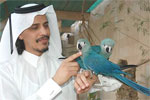The Critically Endangered Fiji petrel has been observed at sea for the first time by BirdLife International and NatureFiji-MareqetiViti.
First recorded in 1855 from one specimen found on Gau Island, Fiji, the rare seabird disappeared from scientific view for 130 years. Beginning in 1984 a handful of ‘grounded’ Fiji petrels Pseudobulweria macgillivrayi were found after landing on village roofs in Gau, but this is the first observation of the bird in its element: at sea.
“[The] Fiji petrel is one of 192 bird species which are Critically Endangered,” said Jez Bird, Global Species Officer at BirdLife International. “Because Fiji Petrel is exceptionally rare and extremely poorly known any new data concerning range and abundance are vital to its conservation.”
Searching south of Gau, an expedition succeeded in sighting eight Fiji petrels in eleven days. Researchers received their first chance to record the species flight and behavior, and also to compare it to other seabirds.
Expedition member Tony Pym said, “To see such a little-known bird at such close range was magical.”
The expedition did not stumble on the rare bird, but strategically sought it out. They lured the seabirds with chum specially prepared by volunteers with NatureFiji-MareqetiViti.
The scientists with the expedition believe that the species is rightly classified as Critically Endangered.
“We observed only a few Fiji Petrels,” said Hadoram Shirihai, lead author of the paper describing the discovery in the Bulletin of the British Ornithologists’ Club. “This was despite choosing what we considered to be the optimum month, and a method that would attract all petrels in the vicinity”.
Next year scientists are planning surveys to locate the breeding ground for the Fiji petrels.
“Once we know the location, we can assess what needs to be done to turn around the fortunes of this species,” said Dick Watling of NatureFiji-MareqetiViti.
The expedition took data on other rare petrels, including the Endangered phoenix petrel (Pterodroma alba), as well as Gould’s petrel Pterodroma leucoptera and Parkinson’s petrel (Procellaria parkinsoni), both listed as Vulnerable.
The expedition was financed in part by the Birdlife Preventing Extinctions Programme, which seeks out partners (either individuals or organizations) to help save the 192 bird species currently classified as Critically Endangered by the IUCN. The local organization, NatureFiji-MareqetiViti, is the Birdlife Species Guardian—i.e. partner—for the Fiji petrel.
Related articles
Sheikh goes from collector to conservationist in effort to save the world’s rarest parrot

(09/10/2009) Al Wabra Wildlife Preservation (AWWP) is a private conservation and endangered species breeding-center located in the Arabian gulf State of Qatar. Founded by Sheikh Saoud Bin Mohammed Bin Ali Al-Thani, the facility focuses on work with threatened antelope and bird species. Although AWWP has had great success with numerous endangered animals, the Preserve is most noted for developing a captive breeding program for the Spix’s Macaw, a species of parrot now extinct in the wild and once considered “the world’s most endangered bird species.”
World’s rarest duck flies closer to extinction’s edge
(08/27/2009) The Madagascar pochard, the world’s rarest duck, was already thought to be extinct once. After a last sighting in 1991 the species was thought to have vanished until nine adults and four hatchlings were discovered in 2006. However, conservationists have begun to fear that the species will never recover after a survey this year found only six females.
Conservation group calls on birders to look for extinct species
(08/24/2009) The conservation group, Birdlife International, has called on birders around the world to keep an eye out for birds classified–some over a centruy ago–as extinct.